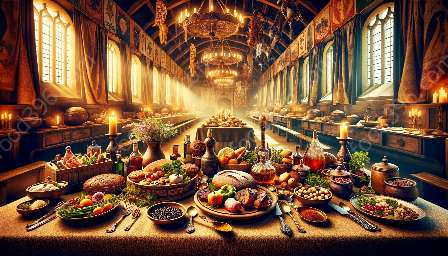The influence of religion on medieval food was profound and multifaceted, shaping diets and culinary practices throughout the Middle Ages. In this exploration, we delve into the historical significance of religious beliefs and their impact on the development of medieval cuisine.
Religion and Dietary Laws
Religion played a significant role in regulating and guiding the diets of medieval people. The doctrines of various religious traditions, notably Christianity and Islam, prescribed specific dietary laws that influenced what foods were consumed and how they were prepared. For example, the Catholic Church imposed periods of fasting and abstinence, such as Lent, during which meat and dairy products were restricted. This led to the development of alternative ingredients and cooking methods to adhere to religious dietary regulations.
Sacred Commensality
In medieval Europe, religious institutions such as monasteries played a central role in the production and distribution of food. Monks and nuns cultivated vast gardens and orchards, producing fruits, vegetables, and herbs that shaped the culinary landscape. The spiritual act of communal dining, often accompanied by prayers and religious rituals, influenced the social and symbolic dimensions of food consumption during this period.
Symbology and Rituals
Religious beliefs infused medieval cuisine with rich symbolic meanings and rituals. Certain foods and culinary practices were imbued with religious allegories and connotations. For instance, the symbolism of bread and wine in Christianity, particularly during the Eucharist, underscored the sacred nature of these staples in medieval diets. This intertwining of food and faith contributed to the development of specialized recipes and culinary traditions.
The Impact of Religious Feast Days
Religious feast days and celebrations punctuated the medieval calendar, influencing the types of foods consumed and the manner in which they were prepared. These occasions often involved elaborate banquets and culinary extravaganzas, showcasing the culinary prowess of medieval cooks and the significance of food within religious celebrations.
Influential Religious Figures
Notable religious figures, including saints and theologians, left indelible imprints on medieval cuisine. Their writings and teachings often emphasized moderation, temperance, and the ethical dimensions of food consumption. The culinary legacies of these figures contributed to the ethical and moral underpinnings of medieval dietary practices.
Innovation and Exchange
Furthermore, the interplay of religion and medieval food fostered culinary innovation and exchange. Religious pilgrimages, trade routes, and interfaith interactions facilitated the transfer of culinary knowledge and ingredients, enriching the gastronomic tapestry of the medieval world.
Legacy and Contemporary Reflections
The influence of religion on medieval food reverberates through the centuries, leaving a lasting legacy on culinary traditions and attitudes towards food. Today, modern interpretations of medieval cuisine often draw inspiration from the religious and cultural contexts of the Middle Ages, offering a lens through which to appreciate the enduring impact of religion on food.

